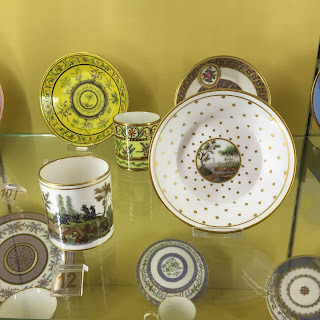The other day I did a post about a visit to the Bowes Museum in Barnard Castle, to see the Silver Swan. It is not the only thing in the huge museum. In fact, the collection is wonderfully eclectic, possibly reflecting the varying interests of Bowes family members over the years.
There is quite a lot of pottery, including:
 |
| Staffordshire dog, 1820 to 1830, painted in coloured enamels |
 |
| Quite a lot of this kind of Wedgwood, which always makes me think of palomino horses, as both of them were tastes of my youth, but no longer, even though I can see that the detail on this is virtuosic |
 |
| this earthenware mug from about 1775, with transfer print |
 |
| all sorts of exquisite Sèvres hand-painted soft paste porcelain made in the late 19th century |
Including this one, which illustrates a La Fontaine fable, in which a mouse decides to retire from mouse society and refuses to help his fellow mice when they are threatened by a cat, painted by Bouchet, who worked at the Sèvres factory from 1757 to 1793
 |
| and these tin-glazed earthenware 18th century models of children in their cradles and babywalkers |
The picture collection includes:
 |
| this, by Phillibert Léon Couturier, called The Poultry Yard, 19th century. I didn't much like it but the Bowes seemed proud of it and had several others by him as well |
 |
| This, by Goya, a portrait of Juan Antonio Menendez Valdés, who according to the caption was a poet and magistrate and, apparently "belonged to the same circle of enlightened Spaniards" as Goya. Menendez was 'passionately concerned about conditions in prisons and lunatic asylums' which is very worthy but makes me think that I might have preferred an evening out with a group of unenlightened Spaniards, all things considered. |
 |
| As I was feeling hungry, I also liked this painting by Jacob van Hulsdonck, who I hadn't heard of before. It was painted in 1614 and is called "Breakfast Piece" (that is my kind of breakfast, yum). The wall tags were very well written and informative at the Bowes and this one pointed out that Chinese porcelain had only recently begun to be imported in large quantities by the Dutch East India company when this picture was made and it includes one of the earliest depictions of it in use at a meal in Europe. |
 |
| This painting intrigued me less as a work of art than as a phenomenon - it is by Ottoavio [sic] Leone (1578-1626- and the forty portraits it assembles are probably copies of prints or drawings. There was an Italian tradition of cycles of portraits of local men and women, celebrated for their virtues, often commissioned by city authorities as an expression of civic pride and to inspire citizens |
 |
| Willem van der Vliet, 183-1642 - Two Girls. This struck me as slightly mysterious and oddly contemporary - it could make a good book cover (or perhaps inspire a novel that could then display it on its front) |
 |
| Having never heard of Jacob von Hulsdonck, I was surprised to see a second picture by him - nothing terrifically exciting about it, but I thought it could be a restful addition to the walls, if for some reason the Bowes Museum decided to give me a present (although Clara would be my first choice) |
 |
| Painted by Blas de Ledesma (c 1580 - c 1640), another artist I had known nothing of before seeing this at the Bowes Supposedly the basket at the centre of this painting is something he used again and again, which is precisely the kind of pointless detail I love being given. |
 |
I love this painting from 1530 by Jan van Amstel, partly because it is my second favourite biblical subject, The Rest on the Flight into Egypt (my favourite of all is the annunciation). The Bowes wall tag tells us that landscape painting had not yet been recognised as a genre in its own right but that it seems clear that the artist was more interested in landscape than in the subject of the painting itself.
I have to admit that this is the object I most covet in the Bowes collection - it is thought to be an image of Clara, an Indian rhino brought to Europe in 1741, after living with the director of the East India company in Bengal and growing used to being around humans and "entertaining" guests at the director's dinner parties by eating from a plate. The man who brought her to Europe "drawing on carpentry skills acquired as a former sea captain built a carriage of massize proportions in order not to jeopardise the well-being of" Clara and travelled from Leiden to Vienna with her, in order to present her to the court of Empress Maria Theresa. 'In the years that followed, Clara was to visit and mesmerise monarchs, landed gentry and ordinary men and women across England, Italy and France."
 |
| Clara |
|
In case you should be hanging around merely in the hope of another glimpse of the silver swan - which is what most visitors at the Bowes tend to be doing - here is its rather terrifying face:
And, if your children are under, (or, come to that, over) 12 and complaining about being bored during lockdown, tell them to shut up until they have produced something as complex and well made as this, produced by a 12 year old in June, 1789:
























No comments:
Post a Comment